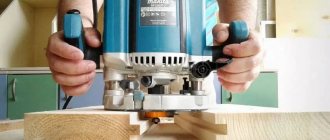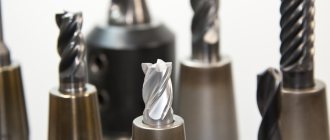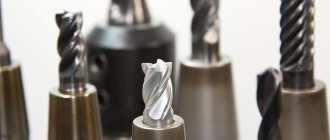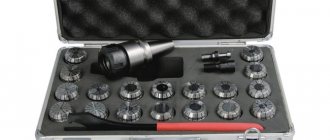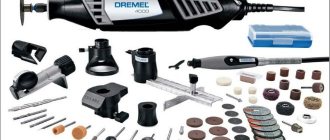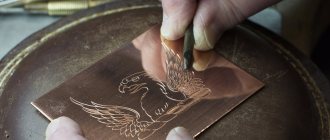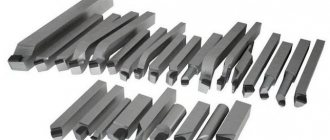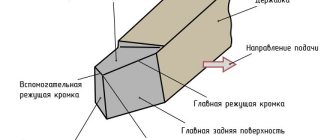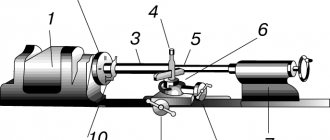A manual milling machine in the hands of a master has a universal application - with its help you can create both basic household items and masterpieces of artistic processing for decoration. However, to use it correctly, you need a suitable cutting tool. Let's look at what types of cutters there are, how they are designed, what their main purpose is, what criteria they are classified by, and how to choose the right one for a specific type of wood processing.
An example of using a wood cutter on a manual machine Source prosto-instrumenty.ru
Milling cutter for a manual wood router - what is it, device, purpose
A milling cutter is the main tool with which wood is processed. The scope of application, purpose, and result depend on its technical characteristics. Despite the fact that there are many varieties of it in terms of shape and features of the cutting edge, materials and other parameters, they are all united by the general principle of the device and the presence of standard parts:
- The cutting area, also called the head or working part. It can have different geometry, composition and blade design.
- Shank - serves as a support for the previous element. With its help, the tool is clamped in the machine chuck, and torque is also transmitted to the main part.
- Additional component. It is located on the very edge of the instrument - opposite the tail section. This could be a support bearing, locking couplings, screws, washers, calibration bushings and other devices. Their task is to simplify or expand the functionality of the cutter, for example, to arrange the cutting segments in the required sequence or to process the workpiece according to a given pattern.
Diagram of an end mill with designation of characteristics Source infradom.ru
Depending on the scope and purpose, modern wood cutters for a manual router allow you to solve the following types of problems:
- Forming edges. It is used when it is necessary to create parts of workpieces that are combined into one structure using a tongue-and-groove connection.
- Creation of cut-outs for installation of fittings.
- Production of decorative forms, cuttings, configurations.
Advice! Certain types of work require your own set of cutting tools. Therefore, before selecting specific types of cutters, it is necessary to determine what the nature, type and volume of wood processing work performed with their help will be.
How to choose cutters
When choosing a cutter, we pay attention to:
- Sharpening Level - Swipe across the paper to see how sharp it is.
- You will see the quality of the alloy by its shine.
- The geometry is determined by external inspection - there should be no distance from the knife to the ruler.
- Soldering - must be located along the entire length so that the cutter does not break.
- Hardness of the alloy - this indicator can be confirmed by quality documents for the product.
A novice specialist can choose budget, that is, inexpensive materials and develop practical skills with them, but in the future for professional work you should not save, otherwise it will affect the quality of the work performed.
Classification of cutters by shank size, type of design and cutting part
Cutting tools for a manual milling machine are classified primarily according to the following three criteria:
- Tail dimensions.
- Type of construction – prefabricated, replaceable blades, monolithic, attachment/set-on.
- Material and method of sharpening the cutting edge.
Let's look at these parameters in more detail.
Set of cutters for woodworking Source instrumentgid.ru
Tail dimensions
In the characteristics of the tail section, the unit of diameter is of paramount importance. The designation must coincide with a similar parameter of the collet - the place where the cutter is mounted in the machine. As a rule, there are only two standards for this value:
- Millimeter. The most common sizes are 6, 8 and 12 mm.
- Inch. There are two main types - half and quarter inches, denoted - ½ and ¼, respectively.
When comparing two measurement systems, it turns out that products with similar diameters differ only by a small amount in size. Thus, 6 mm and ¼ or 6.35 mm cutters and 12 mm and ½ or 12.7 mm cutters look almost the same - however, the holder of a hand router is not adapted to securely hold any type of tool, like a drill chuck.
Therefore, a 12 mm cutter loaded into a ½-inch collet will not sit securely in the chuck and can easily fly out during processing. Likewise, if you load a ½-inch tool into a 12-mm holder, it may jam so much that you will have to come and repair the machine later.
The packaging indicates the size and other main parameters of the cutters Source goods.ru
The second important characteristic is the length of the shank. However, often when choosing the right tool in terms of shape, design, diameter and other parameters, it turns out that it is impossible to find one suitable for the processing conditions of the required length. In this case, special extension adapters come to the rescue.
It should also be remembered that such “helpers” should be used as a last resort and with caution. Since under loads, speeds and revolutions characteristic of modern machines, such a device will always have the property of a “weak link”.
Important! Metric and imperial cutting attachments are not interchangeable. And their use in this capacity can lead not only to damage to the workpiece or machine, but also risks injury to the operator.
See also: Catalog of companies that specialize in garden furniture and storage systems
Type of construction – prefabricated, replaceable blades, monolithic, attachment/set-on
According to the design features of wood cutters, there are 4 main types:
- Prefabricated. It is made by soldering, using refractory solders, the cutting edge to a monolithic base - the shank and the head. They are distinguished by simplicity and accessibility of production.
Example of a prefabricated cylindrical cutter Source atis-market.com
- With replaceable blades. The cutting edge is a separate element, fixed to the head with screws and which the user can replace or sharpen as necessary. Some products have up to 4 working surfaces - which significantly increases the working life of the tool.
- Monolithic. The cutting part is formed directly on the base itself - by analogy with a drill. The advantage is the minimal risk of blade tearing off. However, for prolonged use it must be periodically sharpened, which over time changes the original geometry, impairs performance and leads to the need for replacement.
- Mounted/set-on. The cutting head is connected to the shank in a movable manner. This allows you to change the distance between elements and their sequence for more varied processing of workpieces.
Recommendation! To gain experience and become familiar with processing techniques, a novice user only needs to purchase prefabricated cutters. For the more experienced and professional, kit tools are the best option.
Milling cutter with replaceable blades Source prostanki.com
Material and method of sharpening the cutting edge
The large number of revolutions and the resulting high temperature in the processing zone force tool developers to use the following 2 types of metal alloys as cutting edge materials for wood cutters for hand routers:
- Tool steel. It is marked - HSS. Designed for processing low-density wood at maximum speeds. Disadvantage: when it gets into a denser environment, the cutting edge instantly becomes dull. Therefore, it is not suitable for cutting chipboard, MDF and other similar materials.
- Carbide brazing. Designated - NM. Used for processing dense wood at medium and low speeds. Can also be used for finishing machining with high cutting edge quality. However, it is often impossible to achieve the ideal degree of smoothness when finishing with an average cutter of this type.
Frame cutters with carbide-tipped blades Source zubr-rus.ru
Milling machines. The best types on the market
- HIKKOKI M12SA2 - well suited for making holes of any depth.
- KRUGER KR-1650 is a multifunctional device, suitable for making holes and making grooves.
- Elitech F 1800E - suitable for durable materials, plastic and metal.
- Bosch POF 1400 ACE - for hard wood. Plus low cost, minus heavy weight.
- Makita 3612 C is a powerful device that can operate for many years.
Varieties by processing method
In order to choose the right wood cutter for a hand router, you need to have an idea of what types are used for specific types of work with workpieces. According to this characteristic, cutting tools are divided into 5 main types:
- End.
- Grooved.
- Edges.
- Combined.
- Curvy.
Let us analyze in detail the main features and nuances of using each of them.
End
Having a structure similar to a drill, an end mill, however, differs from it in that its working part extends over the entire area of the cutting edge. That is, wood is sampled with the entire head part. There are the following varieties:
- Profile.
- Spherical.
- Conical.
- Spiral.
- End
- Burr cutters (cutters).
Most end mills have a universal purpose. Thus, spiral varieties allow you to drill and select grooves, quarters, and process ends; profile varieties allow you to make grooves of complex geometry, create ornaments, trim, cutters allow you to finish surfaces, engrave, select special shapes of holes and grooves.
Wood end mill set Source fainaidea.com
Grooved
The very name of the groove cutter reveals the nature of its application - the choice of grooves. However, they differ in the following modifications:
- Fillet. A semicircular sample is formed.
- Conical. Creates a V-shaped groove and is also used for carving surfaces.
- Spiral. They have a structure similar to a drill, but with a larger working part.
- T-shaped. They are used to create grooves of the type where one part slides into another.
- Dovetail. Similar to the above modification - with the difference that the cross-section of the base has the shape of a trapezoid.
- Shaped. It has a wide variety of species. It is used both for making grooves and for processing ends.
- Straight or cylindrical. Create a rectangular groove.
- Combined. They are used to form interlocking joints - when assembling linings, panels, and panels.
Slot milling cutter with performance characteristics displayed Source static-sl.insales.ru
Recommendation! When choosing a specific type of wood cutter for a hand router, you need to have an idea of what they are like in terms of workmanship, thermal strength, connection of the cutting area with the tail part and solder material. When processing hardwood, a tool with weak soldering will soon lose its longitudinal stability and quickly fail.
Edge
An edge cutter is used to create an edge that is smooth and perpendicular to the plane of the workpiece. The following types are distinguished:
- Direct. Designed to create an end perpendicular to the upper plane.
- Moulded. Straight, arched, wavy edges are formed. Used for applying complex patterns. There are also double cutters with the ability to adjust the distance between the blades.
Elliptical and round grooves
To cut grooves in the shape of an ellipse or circle with a hand router, circular devices are used. A simple compass for a router can be made from a rod, the end of which is connected to the base of the tool, and the second is equipped with a pin or screw. To obtain a circle, the rod is inserted into the hole, which serves as the center, and then a groove is formed along the contour.
To change the diameter of the circle, you need to move the tool closer to the other end. A more convenient version of this compass uses two rods instead of one.
Such equipment is quite common and often comes complete with a router. With its help it is convenient to cut shaped grooves with different radii. And when it is necessary to obtain holes of small diameter, other equipment is used. Its peculiarity is that the pin, which is installed in the center of the workpiece, is located under the tool.
- The design of such a compass includes:
- A base that is fixed to the material being processed using screws or vacuum suction cups.
- Two rods.
- Two shoes that fit onto the guides.
- Bracket connecting the router and fixture.
Using the holes in the bracket, the support plate of the equipment is easily aligned with the tool. If a circle is being milled, then only one shoe is used, but for an oval, both are used. Cuts made with this addition are of a higher quality than those made with a band saw or jigsaw.
This occurs due to the characteristics of the tool, which rotates at a very high speed.
Video description
Video instructions for choosing wood cutters for a beginner:
The ends of the workpieces to be joined are given a specific profile using a specific type of cutter. They are then connected by locking into a single, durable structure. The procedure is performed without additional adjustment of the selected surfaces, since the complete tools are perfectly matched to each other.
Curvy
The figuere type cutters are intended for forming panels. Example - baseboards, furniture doors, decorative strips, etc. As a rule, the tool is quite massive, and therefore machines with a power of 1.6 kW or more are used to process workpieces with it. In this case, cutters are divided into three categories:
- Horizontal. Create a panel.
- Double-sided. A panel and tenon are formed.
- Vertical. Used for selecting the profile of skirting boards.
On a note! By itself, even a good hand router and correctly selected cutters for the type of wood processing do not guarantee the planned result. For quality work, you will need a set of suitable stops and templates.
The best milling cutter manufacturers
- Set Fit 6 pieces. Perfectly packaged and suitable for a young master.
- Bit Fit 36692 aybr masters for spot machining. The advantage is that it is a one-piece purchase.
- Set CALIBER 0504 work for wood.
- Total TACSR 1121 great functionality.
- Set STAYER 2992-H12 for soft types of wood.
Briefly about the main thing
The milling cutter is the main cutting tool of a manual milling machine. Among its main parts are:
- Cutting part.
- Shank.
- Additional components.
It is used for various roughing and finishing tasks in woodworking - cutting grooves, trimming, forming interlocking joints, cutting, decorative design, etc. Milling cutters for wood processing are classified primarily according to a number of parameters such as the diameter and length of the tail, the type of design, the material from which the cutting edge is made and the method of sharpening it.
In addition, according to the method of processing the material, they differ into end, edge, groove, combined and figured. Each modification has its own characteristics and nuances of application.
Cutting grooves on narrow surfaces
The home handyman is often faced with the need to cut grooves for a door lock or hinges. As a rule, a chisel and a drill were used for this. But this procedure can be carried out much faster and easier if you use a milling cutter with special equipment. This design allows you to easily create grooves on narrow surfaces and is a flat base that is mounted on the tool.
And also two pins are additionally installed, which ensure the movement of the cutter in a straight line.
The main requirement for this design: the pins must be located in the center of the material being processed. If this condition has been met, then the groove will be located strictly in the middle. To shift the direction of processing, it is enough to put a sleeve of the required size on one of the pins. When using such an attachment, you must ensure that its edges are pressed tightly to the sides during processing.
If you need to cut a groove on a narrow surface, but there is no necessary equipment, then this problem is solved with the help of two boards. They are attached on both sides of the product in one plane. And the power tool itself is fixed with a parallel stop.
The use of such an attachment for a door hinge router allows you to:
- Make the most accurate notch without spending a lot of effort.
- Minimize the possibility of an error, the probability of which is very high without using a template.
